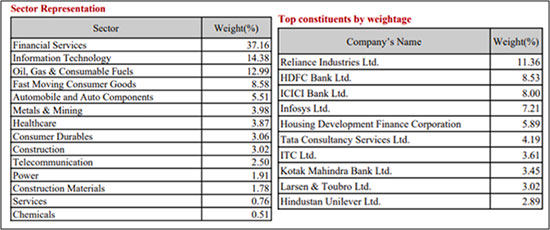IIFL ELSS Nifty 50 Tax Saver Index Fund: Is it Worth Investing in India’s First Passive ELSS?
Mitali Dhoke
Dec 09, 2022 / Reading Time: Approx. 8min
Listen to IIFL ELSS Nifty 50 Tax Saver Index Fund: Is it Worth Investing in India’s First Passive ELSS?
00:00
00:00
IIFL Mutual Fund has launched India's first ever passive ELSS Fund - IIFL ELSS Nifty 50 Tax Saver Index Fund. It is an open-ended Passive Equity Linked Saving Scheme with a statutory lock-in period of 3 years and tax benefit, replicating/tracking the Nifty 50 Index.
[Read: 3 Best ELSS to Invest in 2023 - Top Performing Tax Saving Mutual Funds in India]
Table 1: Details of IIFL ELSS Nifty 50 Tax Saver Index Fund
| Type |
An open-ended Passive Equity Linked Saving Scheme with a statutory lock-in period of 3 years and tax benefit, replicating/tracking the Nifty 50 index. |
Category |
Equity Linked Savings Scheme (ELSS) |
| Investment Objective |
The investment objective of the scheme is to invest in stocks comprising the Nifty 50 Index in the same proportion as in the index to achieve returns equivalent to the Total Returns Index of the Nifty 50 Index (subject to tracking error) while offering deduction on such investment made in the scheme under section 80C of the Income-tax Act, 1961. It also seeks to distribute income periodically depending on distributable surplus.
There is no assurance or guarantee that the investment objective of the scheme will be achieved. |
| Min. Investment |
Rs 500/- and in multiples of Re 1 thereafter. Additional Purchase Rs 500/- and in multiples of Re 1 thereafter. |
Face Value |
Rs 10/- per unit |
| Plans |
|
Options |
- Growth
- Income Distribution cum Capital Withdrawal (IDCW)
|
| Entry Load |
Not Applicable |
Exit Load |
Nil |
| Fund Manager |
Mr Parijat Garg |
Benchmark Index |
Nifty 50 TRI Index |
| Issue Opens: |
December 01, 2022 |
Issue Closes: |
December 21, 2022 |
(Source: Scheme Information Document)
What will be the investment strategy for IIFL ELSS Nifty 50 Tax Saver Index Fund?
IIFL ELSS Nifty 50 Tax Saver Index Fund will adopt a passive investment strategy. The scheme will invest in stocks comprising the Nifty 50 Index in the same proportion as in the index with the objective of achieving returns equivalent to the index, subject to tracking errors.
 Image source: www.freepik.com
Image source: www.freepik.com
Join Now: PersonalFN is now on Telegram. Join FREE Today to get 'Daily Wealth Letter' and Exclusive Updates on Mutual Funds
The fund manager's endeavour would be to rebalance the portfolio in order to replicate the index; however, there may be a short period where the constituents of the portfolio may differ from that of the Underlying Index. These investments which fall outside the Underlying Index as mentioned above shall be rebalanced within a period of 7 calendar days.
Table 2: Asset Allocation for IIFL ELSS Nifty 50 Tax Saver Index Fund
| Instruments |
Indicative Allocations (% of Net Assets) |
Risk Profile |
| Minimum |
Maximum |
High/Medium/Low |
| Equity instruments covered by the Nifty 50 Index |
95 |
100 |
High |
| Debt and money market instruments |
0 |
5 |
Low to Medium |
(Source: Scheme Information Document)
About the benchmark
The NIFTY 50 Index is a well-diversified index comprising 50 companies reflecting overall market conditions. NIFTY 50 Index is computed using the free float market capitalisation method.
Here's the list of top constituents by their weightage and sector representation under the index as on November 30, 2022:
 (Source: NSE Nifty 50 Index)
(Source: NSE Nifty 50 Index)
# Note that the index will rebalance semi-annually in January and July.
Should you invest in IIFL ELSS Nifty 50 Tax Saver Index Fund?
IIFL ELSS Nifty 50 Tax Saver Index Fund aims to invest in stocks comprising the Nifty 50 Index in the same proportion as in the index, subject to tracking errors. The scheme has a statutory lock-in period of 3 years with tax benefits and has the potential to generate higher returns as compared to other tax-saving investment options like PPF, debt funds, etc.
This scheme is the first passive ELSS Fund in the tax-saving mutual fund category. ELSS funds are type of mutual funds that qualify for a tax deduction, you can claim up to Rs 1.5 Lac as a deduction u/s 80C of the Income-Tax Act. The scheme provides exposure to high-quality Nifty companies with tax-saving as well as wealth-creation opportunities. The underlying Nifty 50 Index invests in the top 50 stocks by market capitalisation across sectors. Being a passively managed tax saving index fund, the scheme has a relatively lower cost as compared to active ELSS funds.
However, do note that since the scheme invests a majority of its assets in equities, it is not free from inherent high market risks, and investors will not be allowed to liquidate their holdings during the lock-in period. In addition, the persistent repercussions of geopolitical tensions, spiralling inflation, and the recent hike in policy rates by 35 bps to curb inflation may cause a significant risk to economic growth. The margin of safety appears to be narrow, and the clear direction for the equity market from the current elevated levels is uncertain. These factors, among others, may impact the top constituents in the index weighing down on the returns clocked and the scheme may face intensified volatility in the near term.
Therefore, the scheme is suitable for investors looking for tax-saving options at low cost and has an investment horizon of a minimum of 5 years for the fund to grow and realise substantial appreciation of the investment. Ensure that you have a high-risk appetite and that your objectives align with the fund.
Warm Regards,
Mitali Dhoke
Research Analyst